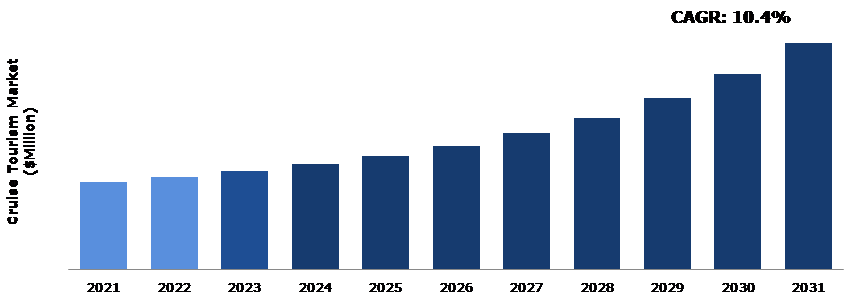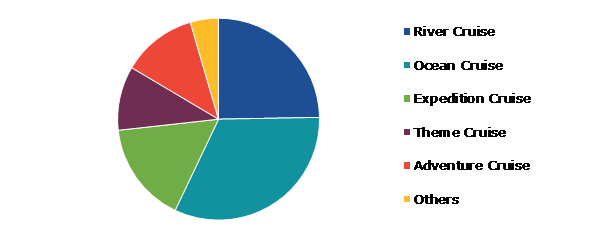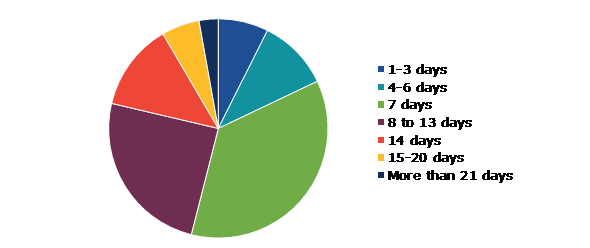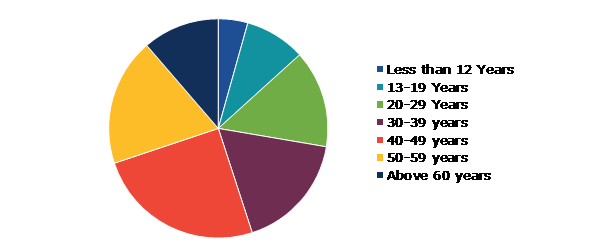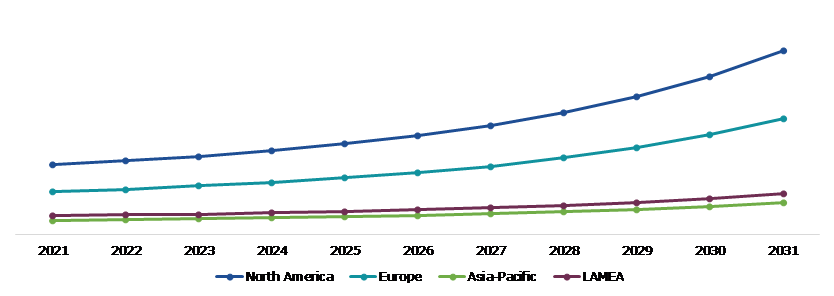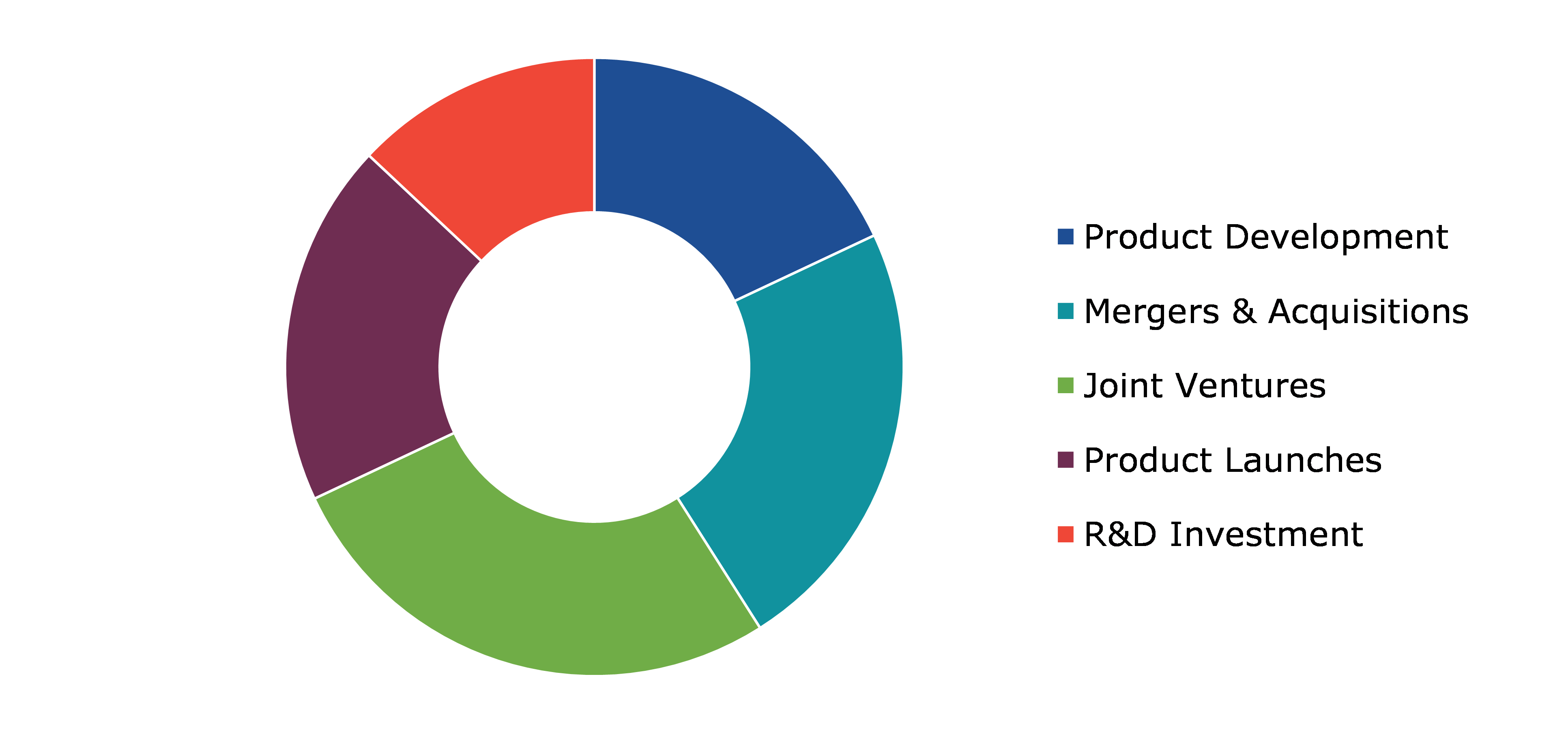Cruise Tourism Market Report
RA00107
Cruise Tourism Market by Cruise Type (River Cruise, Ocean Cruise, Expedition Cruise, Theme Cruise, Adventure Cruise, and Others), Duration (1-3 days, 4-6 days, 7 days, 8 to 13 days, 14 days, 15-20 days, and more than 21 days), Passenger Age (Less than 12 Years, 13-19 Years, 20-29 Years, 30-39 years, 40-49 years, 50-59 years, and Above 60 years) and Region (North America, Europe, Asia-Pacific, and LAMEA): Global Opportunity Analysis and Industry Forecast, 2022-2031
Global Cruise Tourism Market Analysis
The Global Cruise Tourism Market Size was $5,288.8 million in 2021 and is predicted to grow with a CAGR of 10.4%, by generating a revenue of $13,641.4 million by 2031.
Global Cruise Tourism Market Synopsis
The disposable income is a crucial driver of the cruise tourism market. When people have more money to spend, they are more likely to allocate a portion of their income to travel and leisure activities, including cruise vacations. As the global economy improves, individuals and families tend to have more disposable income available, and they are more inclined to take vacations and experience new destinations. Additionally, as disposable income increases, people are more likely to consider more extravagant and luxurious forms of travel, such as cruises. Cruise vacations can offer a wide range of activities, entertainment, dining options, and excursions, all in one convenient package. Therefore, as people have more money to spend, they are more likely to choose a cruise vacation as a way to maximize their travel experience. These factors are anticipated to boost the cruise tourism industry growth in the upcoming years.
However, the high cost of cruise tourism can certainly be a factor in limiting the growth of the market. In times of economic uncertainty, many consumers may be more cautious with their spending and may be less willing to invest in an expensive vacation option like a cruise. To address this restraint, cruise companies may need to consider pricing strategies that make cruises more accessible to a wider range of consumers. This could include offering lower-cost options or special deals and promotions, as well as creating packages that bundle in additional amenities and services at a discounted price.
The cruise tourism industry presents significant opportunities for luxury tourism. Luxury cruise ships offer a range of amenities and services that cater to the demands for affluent travelers, including gourmet dining, spa treatments, and personalized attention from highly trained staff. Many luxury cruise lines also offer unique and exclusive experiences, such as private islands, high-end shopping, and VIP access to cultural attractions. This appeals to travelers who value exclusivity, comfort, and a high level of service. The demand for luxury cruise travel has been steadily increasing in recent years, with many travelers seeking unique and memorable experiences. As a result, the luxury cruise market has become a significant opportunity of the overall cruise industry.
According to regional analysis, the North America cruise tourism market accounted for the highest market share in 2021. The North American region has a strong and stable economy, which has helped to support the growth of the cruise tourism market. Consumers are willing to spend money on vacations, and the cruise industry has been able to provide them with a range of affordable options.
Cruise Tourism Overview
Cruise tourism refers to the industry and activity of taking a vacation or trip on a cruise ship, which is a large passenger vessel that travels on the open sea or on inland waterways. Cruise tourism typically involves passengers embarking on a multi-day or multi-week trip that includes various ports of call and activities onboard the ship, such as dining, entertainment, and relaxation. Cruise tourism is a significant sector of the global tourism industry, with millions of people taking cruises each year to explore different destinations and enjoy the amenities and activities offered by the cruise ships.
COVID-19 Impact on Global Cruise Tourism Market
The COVID-19 pandemic has had a significant impact on the cruise tourism market. With travel restrictions, lockdowns, and health concerns, the demand for cruise travel has decreased significantly. As a result, the cruise industry has suffered substantial losses and had to make significant changes to its operations to adapt to the new circumstances. Moreover, the most significant impacts of COVID-19 on the cruise industry is the suspension of cruise operations.
Many cruise lines have had to cancel their voyages or suspend their operations for an extended period. This has resulted in a massive loss of revenue for the industry and has also affected the businesses that depend on the cruise tourism market, such as port operators, travel agents, and tour operators. The health and safety protocols that have been put in place to prevent the spread of COVID-19 have also affected the cruise industry.
Cruise ships are required to follow strict health and safety guidelines, such as regular cleaning and disinfecting, mandatory mask-wearing, social distancing, and temperature checks. These protocols have increased the cost of operation for the cruise lines and have also affected the passenger experience. The COVID-19 pandemic has had a profound impact on the cruise tourism market, resulting in significant losses and changes to the industry's operations. However, the cruise industry is gradually recovering as the vaccination rates increase and travel restrictions ease.
Growing Demand for Luxury Experiences of Cruise Tourism to Drive the Market Growth
The increasing demand for luxury experiences is indeed one of the drivers of the cruise tourism market. Many consumers today are looking for unique and memorable experiences, and are willing to pay a premium for them. This has led to a rise in the popularity of high-end cruise ships, which offer a range of luxurious amenities and activities. These luxury cruise ships often feature spacious cabins, gourmet dining options, high-end entertainment, spa treatments, and other amenities designed to provide guests with a truly luxurious experience. In addition, many luxury cruise lines offer exclusive shore excursions and access to private islands or beaches, further enhancing the overall experience. The growing popularity of luxury tourism facilitated by high-end cruise ships and luxury cruise lines is anticipated to boost the cruise tourism market share in the coming years. This trend is likely to continue in the coming years, as more and more consumers seek out unique and memorable travel experiences.
To know more about global cruise tourism market drivers, get in touch with our analysts here.
Safety and Security Concerns Over Cruise Tourism to Restrain the Market Growth
Safety and security concerns are always a major issue for the cruise tourism industry. Accidents and incidents such as ship collisions, fires, and other disasters can lead to loss of life, injuries, and property damage. These incidents can severely impact the reputation of cruise lines and discourage passengers from booking cruises. Disease outbreaks such as COVID-19 can spread quickly on a cruise ship, affecting hundreds or even thousands of passengers and crew members. Such outbreaks can lead to significant financial losses for cruise lines and create negative publicity. The threat of terrorism is another safety and security concern for the cruise tourism industry. Cruise ships are considered high-value targets, and an attack can have catastrophic consequences for the industry, which is anticipated to hamper the cruise tourism market growth.
Growing Consumer Demand For Cruise Tourism to Generate Excellent Opportunities
The cruise tourism market is experiencing an increasing demand due to various factors such as rising disposable incomes, changing consumer preferences, and the desire for unique travel experiences. In recent years, cruising has become a popular vacation option for people all over the world, with the industry experiencing steady growth. As more people have more disposable income, they are looking for new and exciting ways to spend their vacations. Cruising provides an all-inclusive vacation experience with a wide range of activities and entertainment options. This has made cruising an attractive option for families, couples, and solo travelers alike. Furthermore, consumers are increasingly interested in unique travel experiences that allow them to explore new cultures and destinations. Cruising offers the opportunity to visit multiple destinations in one trip, making it an attractive option for travelers who want to experience different cultures and cuisines. The cruise tourism market is expected to continue to grow as more people seek out unique and exciting travel experiences. This presents significant opportunities for cruise companies, travel agents, and other businesses that cater to the cruise industry.
To know more about global cruise tourism market opportunities, get in touch with our analysts here.
Global Cruise Tourism Market, by Type
Based on type, the market has been divided into river cruise, ocean cruise, expedition cruise, theme cruise, adventure cruise, and others. Among these, the ocean cruise sub-segment accounted for the highest market share in 2021 as well as this sub-segment is estimated to show the fastest growth during the forecast period.
Global Cruise Tourism Market Share, by Type, 2021
Source: Research Dive Analysis
The ocean cruise sub-type accounted for the highest market share in 2021 as well as this sub-segment is estimated to show the fastest growth during the forecast period. The ocean cruise segment includes the development of new destinations and ports of call, the increasing popularity of themed cruises (such as adventure cruises, music cruises, or culinary cruises), and the introduction of new ships with innovative features and amenities. In recent years, cruise lines have been investing heavily in technology and onboard experiences to attract and retain passengers, such as virtual reality experiences, robot bartenders, and immersive entertainment options. The cruise tourism market has seen a significant increase in demand over the years, with more people opting for cruise vacations. This can be attributed to the increasing disposable income, rising middle-class population, and a growing preference for experiential travel.
Global Cruise Tourism Market, by Duration
Based on duration, the market has been divided into 1-3 days, 4-6 days, 7 days, 8 to 13 days, 14 days, 15-20 days, and more than 21 days. Among these, the 7 days sub-segment accounted for highest revenue share in 2021.
Global Cruise Tourism Market Trends, by Duration, 2021
Source: Research Dive Analysis
The 7 days sub-segment accounted for the highest market share in 2021. In 7 days, segment is rising income levels across the world, people have more money to spend on leisure activities like vacations. This has led to an increase in demand for cruise tourism, particularly in the 7-day segment. Cruising has become an increasingly popular way to travel, particularly in the 7-day segment. With more people looking for all-inclusive vacations, cruises offer a convenient and cost-effective way to see multiple destinations without having to worry about transportation, accommodation, and food. Cruise lines have been investing heavily in expanding their fleet and upgrading their ships to meet the growing demand. These factors are anticipated to boost the growth of 7 days sub-segment during the analysis timeframe.
Global Cruise Tourism Market, by Passenger Age
Based on passenger age, the market has been divided into Less than 12 years, 13-19 years, 20-29 years, 30-39 years, 40-49 years, 50-59 years and Above 60 years. Among these, the 40-49 years sub-segment accounted for highest revenue share in 2021.
Global Cruise Tourism Market Growth, by Passenger Age, 2021
Source: Research Dive Analysis
The 40-49 years sub-segment accounted for the highest market share in 2021. The 40-49 years segment in the cruise tourism market is expected to be individuals in this age range who are looking for a combination of relaxation, adventure, and luxury. They may be seeking a break from their busy work schedules or family responsibilities and want to unwind in a picturesque location with plenty of amenities and activities. This age group tends to be more financially stable and can afford the higher-end cruises that offer more amenities and services. They are also more likely to be interested in unique experiences, such as eco-tourism or cultural excursions, and may be more willing to spend money on these types of activities. These factors are anticipated to boost the growth of 40-49 years sub-segment during the analysis timeframe.
Global Cruise Tourism Market, Regional Insights
The cruise tourism market was investigated across North America, Europe, Asia-Pacific, and LAMEA.
Global Cruise Tourism Market Size & Forecast, by region, 2021-2031 (USD Million)
Source: Research Dive Analysis
The Market for Cruise Tourism in North America to be the Most Dominant
The North America cruise tourism market accounted for the highest market share in 2021. The North America due to the growing popularity of cruising as a vacation option. Many people are attracted to the convenience, comfort, and luxury of cruising, which has contributed to the growth of the industry. North America has a large population of baby boomers, who are more likely to take cruises than younger generations. Additionally, the rising middle class in North America has increased the number of people who can afford to take cruises, further driving demand. North America offers a wide range of destinations for cruise ships to visit, from the Caribbean and Mexico to Alaska and Canada. The diversity of these destinations appeals to a broad range of travelers and has helped to fuel the growth of the cruise tourism market in the region. The cruise industry in North America has invested heavily in marketing and promoting their products to potential customers. This has helped to raise awareness of cruising as a vacation option and has contributed to the growth of the industry.
Competitive Scenario in the Global Cruise Tourism Market
Investment and agreement are common strategies followed by major market players. For instance, in January 2019, Zen Cruises, a division of the Essel Group, announced that Jalesh Cruises would set sail for the first time from Mumbai in April. The multi-destination cruise line will provide worldwide hospitality on the open sea in addition to entertainment performances, adventure activities, and exotic authentic foods.
Source: Research Dive Analysis
Some of the leading cruise tourism market players are Ambassador Cruise Holidays Limited., AmaWaterways, Carnival Corporation & plc, Ponant, Cosmos Tours Ltd., Kerala Shipping and Inland Navigation Corporation Ltd., Mediterranean Shipping Company S.A., Norwegian Cruise Line, Silversea Cruises, and Seabourn Cruise Line.
| Aspect | Particulars |
| Historical Market Estimations | 2020 |
| Base Year for Market Estimation | 2021 |
| Forecast Timeline for Market Projection | 2021-2031 |
| Geographical Scope | North America, Europe, Asia-Pacific, LAMEA |
| Segmentation by Type |
|
| Segmentation by Duration |
|
| Segmentation by Passenger Age |
|
| Key Companies Profiled |
|
Q1. What is the size of the global cruise tourism market?
A. The size of the global cruise tourism market was over $5,288.8 million in 2021 and is projected to reach $13,641.4 million by 2031.
Q2. Which are the major companies in the cruise tourism market?
A. Ambassador Cruise Holidays Limited., AmaWaterways, and Carnival Corporation & plc are some of the key players in the global cruise tourism market.
Q3. Which region, among others, possesses greater investment opportunities in the near future?
A. The Europe region possesses great investment opportunities for investors to witness the most promising growth in the future.
Q4. What will be the growth rate of the Europe cruise tourism market?
A. Europe cruise tourism market is anticipated to grow at 11.1% CAGR during the forecast period.
Q5. What are the strategies opted by the leading players in this market?
A. Agreement and investment are the two key strategies opted by the operating companies in this market.
Q6. Which companies are investing more on R&D practices?
A. PONANT, Kerala Shipping and Inland Navigation Corporation Ltd., and Mediterranean Shipping Company S.A. are the companies investing more on R&D activities for developing new products and technologies.
1.Research Methodology
1.1.Desk Research
1.2.Real time insights and validation
1.3.Forecast model
1.4.Assumptions and forecast parameters
1.5.Market size estimation
1.5.1.Top-down approach
1.5.2.Bottom-up approach
2.Report Scope
2.1.Market definition
2.2.Key objectives of the study
2.3.Report overview
2.4.Market segmentation
2.5.Overview of the impact of COVID-19 on Global cruise tourism market
3.Executive Summary
4.Market Overview
4.1.Introduction
4.2.Growth impact forces
4.2.1.Drivers
4.2.2.Restraints
4.2.3.Opportunities
4.3.Market value chain analysis
4.3.1.List of service providers
4.3.2.List of distributors
4.4.Innovation & sustainability matrices
4.4.1.Technology matrix
4.4.2.Regulatory matrix
4.5.Porter’s five forces analysis
4.5.1.Bargaining power of suppliers
4.5.2.Bargaining power of consumers
4.5.3.Threat of substitutes
4.5.4.Threat of new entrants
4.5.5.Competitive rivalry intensity
4.6.PESTLE analysis
4.6.1.Political
4.6.2.Economical
4.6.3.Social
4.6.4.Technological
4.6.5.Environmental
4.7.Impact of COVID-19 on cruise tourism market
4.7.1.Pre-covid market scenario
4.7.2.Post-covid market scenario
5.Cruise Tourism Market Analysis, by Type
5.1.Overview
5.2.River Cruise
5.2.1.Definition, key trends, growth factors, and opportunities
5.2.2.Market size analysis, by region,2021-2031
5.2.3.Market share analysis, by country,2021-2031
5.3.Ocean Cruise
5.3.1.Definition, key trends, growth factors, and opportunities
5.3.2.Market size analysis, by region,2021-2031
5.3.3.Market share analysis, by country,2021-2031
5.4.Expedition Cruise
5.4.1.Definition, key trends, growth factors, and opportunities
5.4.2.Market size analysis, by region,2021-2031
5.4.3.Market share analysis, by country,2021-2031
5.5.Theme Cruise
5.5.1.Definition, key trends, growth factors, and opportunities
5.5.2.Market size analysis, by region,2021-2031
5.5.3.Market share analysis, by country,2021-2031
5.6.Adventure Cruise
5.6.1.Definition, key trends, growth factors, and opportunities
5.6.2.Market size analysis, by region,2021-2031
5.6.3.Market share analysis, by country,2021-2031
5.7.Others
5.7.1.Definition, key trends, growth factors, and opportunities
5.7.2.Market size analysis, by region,2021-2031
5.7.3.Market share analysis, by country,2021-2031
5.8.Research Dive Exclusive Insights
5.8.1.Market attractiveness
5.8.2.Competition heatmap
6.Cruise Tourism Market Analysis, by Duration
6.1.1-3 days
6.1.1.Definition, key trends, growth factors, and opportunities
6.1.2.Market size analysis, by region,2021-2031
6.1.3.Market share analysis, by country,2021-2031
6.2.4-6 days
6.2.1.Definition, key trends, growth factors, and opportunities
6.2.2.Market size analysis, by region,2021-2031
6.2.3.Market share analysis, by country,2021-2031
6.3.7 days
6.3.1.Definition, key trends, growth factors, and opportunities
6.3.2.Market size analysis, by region,2021-2031
6.3.3.Market share analysis, by country,2021-2031
6.4.8 to 13 days
6.4.1.Definition, key trends, growth factors, and opportunities
6.4.2.Market size analysis, by region,2021-2031
6.4.3.Market share analysis, by country,2021-2031
6.5.14 days
6.5.1.Definition, key trends, growth factors, and opportunities
6.5.2.Market size analysis, by region,2021-2031
6.5.3.Market share analysis, by country,2021-2031
6.6.15-20 days
6.6.1.Definition, key trends, growth factors, and opportunities
6.6.2.Market size analysis, by region,2021-2031
6.6.3.Market share analysis, by country,2021-2031
6.7.More than 21 days
6.7.1.Definition, key trends, growth factors, and opportunities
6.7.2.Market size analysis, by region,2021-2031
6.7.3.Market share analysis, by country,2021-2031
6.8.Research Dive Exclusive Insights
6.8.1.Market attractiveness
6.8.2.Competition heatmap
7.Cruise Tourism Market, by region
7.1.North America
7.1.1.U.S.
7.1.1.1.Market size analysis, by Cruise Tourism
7.1.1.2.Market size analysis, by Duration
7.1.1.3.Market size analysis, by Passenger Age
7.1.2.Canada
7.1.2.1.Market size analysis, by Cruise Tourism
7.1.2.2.Market size analysis, by Duration
7.1.2.3.Market size analysis, by Passenger Age
7.1.3.Mexico
7.1.3.1.Market size analysis, by Cruise Tourism
7.1.3.2.Market size analysis, by Duration
7.1.3.3.Market size analysis, by Passenger Age
7.1.4.Research Dive Exclusive Insights
7.1.4.1.Market attractiveness
7.1.4.2.Competition heatmap
7.2.Europe
7.2.1.Germany
7.2.1.1.Market size analysis, by Cruise Tourism
7.2.1.2.Market size analysis, by Duration
7.2.1.3.Market size analysis, by Passenger Age
7.2.2.UK
7.2.2.1.Market size analysis, by Cruise Tourism
7.2.2.2.Market size analysis, by Duration
7.2.2.3.Market size analysis, by Passenger Age
7.2.3.France
7.2.3.1.Market size analysis, by Cruise Tourism
7.2.3.2.Market size analysis, by Duration
7.2.3.3.Market size analysis, by Passenger Age
7.2.4.Spain
7.2.4.1.Market size analysis, by Cruise Tourism
7.2.4.2.Market size analysis, by Duration
7.2.4.3.Market size analysis, by Passenger Age
7.2.5.Italy
7.2.5.1.Market size analysis, by Cruise Tourism
7.2.5.2.Market size analysis, by Duration
7.2.5.3.Market size analysis, by Passenger Age
7.2.6.Rest of Europe
7.2.6.1.Market size analysis, by Cruise Tourism
7.2.6.2.Market size analysis, by Duration
7.2.6.3.Market size analysis, by Passenger Age
7.2.7.Research Dive Exclusive Insights
7.2.7.1.Market attractiveness
7.2.7.2.Competition heatmap
7.3.Asia Pacific
7.3.1.China
7.3.1.1.Market size analysis, by Cruise Tourism
7.3.1.2.Market size analysis, by Duration
7.3.1.3.Market size analysis, by Passenger Age
7.3.2.Thailand
7.3.2.1.Market size analysis, by Cruise Tourism
7.3.2.2.Market size analysis, by Duration
7.3.2.3.Market size analysis, by Passenger Age
7.3.3.India
7.3.3.1.Market size analysis, by Cruise Tourism
7.3.3.2.Market size analysis, by Duration
7.3.3.3.Market size analysis, by Passenger Age
7.3.4.South Korea
7.3.4.1.Market size analysis, by Cruise Tourism
7.3.4.2.Market size analysis, by Duration
7.3.4.3.Market size analysis, by Passenger Age
7.3.5.Malaysia
7.3.5.1.Market size analysis, by Cruise Tourism
7.3.5.2.Market size analysis, by Duration
7.3.5.3.Market size analysis, by Passenger Age
7.3.6.Rest of Asia-Pacific
7.3.6.1.Market size analysis, by Cruise Tourism
7.3.6.2.Market size analysis, by Duration
7.3.6.3.Market size analysis, by Passenger Age
7.3.7.Research Dive Exclusive Insights
7.3.7.1.Market attractiveness
7.3.7.2.Competition heatmap
7.4.LAMEA
7.4.1.Brazil
7.4.1.1.Market size analysis, by Cruise Tourism
7.4.1.2.Market size analysis, by Duration
7.4.1.3.Market size analysis, by Passenger Age
7.4.2.United Arab Emirates
7.4.2.1.Market size analysis, by Cruise Tourism
7.4.2.2.Market size analysis, by Duration
7.4.2.3.Market size analysis, by Passenger Age
7.4.3.Saudi Arabia
7.4.3.1.Market size analysis, by Cruise Tourism
7.4.3.2.Market size analysis, by Duration
7.4.3.3.Market size analysis, by Passenger Age
7.4.4.South Africa
7.4.4.1.Market size analysis, by Cruise Tourism
7.4.4.2.Market size analysis, by Duration
7.4.4.3.Market size analysis, by Passenger Age
7.4.5.Rest of LAMEA
7.4.5.1.Market size analysis, by Cruise Tourism
7.4.5.2.Market size analysis, by Duration
7.4.5.3.Market size analysis, by Passenger Age
7.4.6.Research Dive Exclusive Insights
7.4.6.1.Market attractiveness
7.4.6.2.Competition heatmap
8.Competitive Landscape
8.1.Top winning strategies, 2021
8.1.1.By strategy
8.1.2.By year
8.2.Strategic overview
8.3.Market share analysis, 2021
9.Company Profiles
9.1.Ambassador Cruise Holidays Limited
9.1.1.Overview
9.1.2.Business segments
9.1.3.Product portfolio
9.1.4.Financial performance
9.1.5.Recent developments
9.1.6.SWOT analysis
9.2.AmaWaterways
9.2.1.Overview
9.2.2.Business segments
9.2.3.Product portfolio
9.2.4.Financial performance
9.2.5.Recent developments
9.2.6.SWOT analysis
9.3.Carnival Corporation & plc
9.3.1.Overview
9.3.2.Business segments
9.3.3.Product portfolio
9.3.4.Financial performance
9.3.5.Recent developments
9.3.6.SWOT analysis
9.4. Ponant
9.4.1.Overview
9.4.2.Business segments
9.4.3.Product portfolio
9.4.4.Financial performance
9.4.5.Recent developments
9.4.6.SWOT analysis
9.5.Cosmos Tours Ltd.
9.5.1.Overview
9.5.2.Business segments
9.5.3.Product portfolio
9.5.4.Financial performance
9.5.5.Recent developments
9.5.6.SWOT analysis
9.6.Kerala Shipping and Inland Navigation Corporation Ltd.
9.6.1.Overview
9.6.2.Business segments
9.6.3.Product portfolio
9.6.4.Financial performance
9.6.5.Recent developments
9.6.6.SWOT analysis
9.7.Mediterranean Shipping Company S.A.
9.7.1.Overview
9.7.2.Business segments
9.7.3.Product portfolio
9.7.4.Financial performance
9.7.5.Recent developments
9.7.6.SWOT analysis
9.8.Norwegian Cruise Line
9.8.1.Overview
9.8.2.Business segments
9.8.3.Product portfolio
9.8.4.Financial performance
9.8.5.Recent developments
9.8.6.SWOT analysis
9.9.Silversea Cruises
9.9.1.Overview
9.9.2.Business segments
9.9.3.Product portfolio
9.9.4.Financial performance
9.9.5.Recent developments
9.9.6.SWOT analysis
9.10. Seabourn Cruise Line
9.10.1.Overview
9.10.2.Business segments
9.10.3.Product portfolio
9.10.4.Financial performance
9.10.5.Recent developments
9.10.6.SWOT analysis
Cruise tourism, a subset of the global tourism sector, refers to spending a vacation or a holiday on a cruise ship where entertainment, dining, and other services are provided. Cruise tourism is becoming increasingly popular in the North Atlantic and North Pacific regions where the exotic marine life and temperate climates further add to the aesthetics of the marine habitat. In the past few years, Australia, Southeast Asia, and the Caribbean have also gained a lot of attention as they have developed their cruise tourism destinations wonderfully.
Forecast Analysis of the Cruise Tourism Market
Over the years, there has been an increase in the disposable incomes and private final consumption expenditure of global populations which is predicted to push the global cruise tourism market forward in the forecast years. Along with this, rising demand for luxury tourism is expected to boost the market further. Furthermore, increasing demand from customers for inclusive vacation experiences is predicted to offer numerous growth opportunities to the market in the analysis timeframe. However, safety and security concerns may hamper the growth of the cruise tourism market in the 2022-2031 timeframe.
Regionally, the cruise tourism market in the North America region is expected to have the most dominant market share in the forecast period. The rising middle class in various countries of the North America region is expected to be the primary growth driver of the market in this region.
As per a report by Research Dive, the global cruise tourism market is expected to reach a revenue of $13,641.4 million in the 2022–2031 timeframe, thereby growing at a stunning CAGR of 10.4% by 2031. Some prominent market players include Ambassador Cruise Holidays Limited., Cosmos Tours Ltd., Norwegian Cruise Line, AmaWaterways, Kerala Shipping and Inland Navigation Corporation Ltd., Silversea Cruises, Carnival Corporation & plc, Mediterranean Shipping Company S.A., Seabourn Cruise Line, Ponant, and many others.
Covid-19 Impact on the Market
The Covid-19 pandemic and the subsequent lockdowns have had a catastrophic impact on various businesses and markets worldwide. The cruise tourism market, too, faced tremendously negative impact of the pandemic. The travel restrictions put in place by various countries led to a massive decline in the number of tourists and travelers which reduced the growth rate of the market in the pandemic period.
Significant Market Developments
The key players of the market are adopting various business strategies such as partnerships, mergers & acquisitions, and launches to gain a leading position in the market, thus helping the cruise tourism market to flourish. For instance:
- In August 2022, Juniper, a leading technological solutions provider for the travel industry, announced the acquisition of IST, a technology partner in the sale of cruises. Juniper plans to open a new vertical of cruises and this acquisition is anticipated to help the company to achieve its aim in the near future.
- In March 2023, Saudi Arabia announced that it was acquiring Genting Hong Kong’s World Dream cruise ship in a bid to expand its cruise industry in the Kingdom of Saudi Arabia. This acquisition is in line with the growing governmental expenditure in the tourism sector that has been taking place in the last few years.
- In April 2023, Disney Cruise Line, a subsidiary of the Walt Disney Company, announced a collaboration with Singapore Tourism Board, a state-owned entity of the Singapore Government. Under this partnership agreement Disney Cruise Line will introduce their cruise ships in the Singapore which will help the country to develop its cruise tourism market substantially in the coming period.
Personalize this research
- Triangulate with your own data
- Request your format and definition
- Get a deeper dive on a specific application, geography, customer or competitor
- + 1-888-961-4454 Toll - Free
- support@researchdive.com

